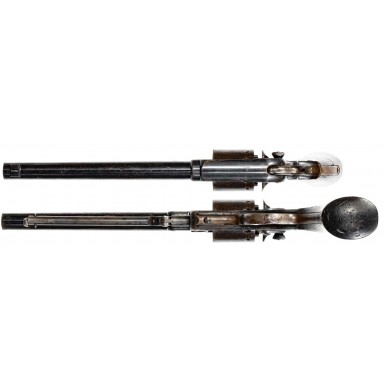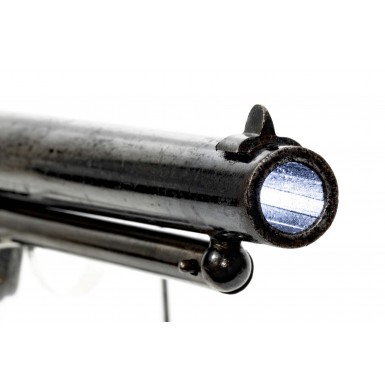Fine Starr Model 1863 Single Action Army Revolver
- Product Code: FHG-2235-SOLD
- Availability: Out Of Stock
-
$1.00
The Starr Arms Model 1863 Percussion “Army” Revolver was designed as a simplified and more robust version of their earlier Starr Model 1858 Double Action Revolver. The simplified action was also intended to be less expensive to produce and thus more cost effective, for the US Government to purchase. Like the earlier M1858 Double Action Army, the gun was a six shot, .44 caliber percussion revolver. However, the M1863 utilized a single action lock work, instead of the delicate and complicated double action lock of the M1858. The M1863 also had a longer barrel, measuring 8” in length. This was an increase of 2” over the earlier M1858. The production of the M1863 started at about serial number 23,000, continuing from the end of the production run of the earlier M1858 Double Action revolver. Some 32,000 of the “improved Army” revolvers were produced by the Starr Arms Company between the end of 1863 and the end of 1865.
In September of 1863, Starr received a contract to deliver 25,000 of their Improved Army Revolvers at the rate of $12.00 each. The contract specified that 1,000 guns were to be delivered during the month of October (1863), with additional deliveries of 2,000 guns per month over the next twelve months until the contract was fulfilled. Starr delivered the first 1,000 of the Single Action M1863 revolvers in December of 1863 and a total of 24,002 over the twelve months of 1864. During the American Civil War, the M1863 Starr was issued to a number of US cavalry regiments, including the 1stColorado Cavalry, the 6th & 7th Michigan Cavalry and the 11th New York Cavalry, just to name a few.
After the Civil War, the obsolete Starr revolvers of all patterns were returned to various US arsenals and remained in storage until they were eventually disposed of. The first major sale of Starr .44 revolvers was in October of 1865, when 99 of the revolvers were sold from the Watervliet Arsenal at the price of $5.00 each. Over the next 36 years Starr revolvers were sold from a number of US Arsenals. The largest single sale of .44 Starr revolvers took place in December of 1870, when the Austin Baldwin Company acquired 20,000 of the revolvers from the New York Arsenal, purchasing them for $8.00 each. The last major sale of .44 Starr revolvers occurred on June 19, 1901, when Francis Bannerman & Company purchased 7,537 of the revolvers from the New York Arsenal, paying between 2.13¢ and 27.55¢ each; a far cry from the original contract price of $12.00 for the single action guns, and $20.00 or more for the earlier double action revolvers.
This is example of the Starr Model 1863 Single Action Army revolver is in FINE condition. The right side of the gun is crisply marked STARR’S PATENT JAN 15 1856 and the left side is marked STARR ARMS Co NEW.YORK. There are a variety US government sub-inspector marks crisply stamped on the frame, barrel, cylinder and trigger guard, primarily the capital letters C and M. The serial number of 39232 is present on the center of the frame below the loading level recess and on the cylinder. The serial number is also found in the frame cut out under the hammer. The revolver’s serial number suggest it was delivered at some time in 1864. The grip also retains two mostly legible inspection cartouches. The script letters GKC are present in an oval cartouche on the left side of the grip, with the script inspection LAB on the right side. The first inspection cartouche is that of George K. Charter, a civilian sub-inspector who not only inspected a large number of Starr revolvers, but also S. Norris & W.T. Clement contract Model 1861 Rifle Muskets and Ames swords. The “LAB” mark is one frequently found on Starr carbines and is the mark of arsenal sub-inspector L.A. Brown. Little is known about Brown, but as noted he inspected Starr carbines as well as handguns, particularly the earlier production Double Action Model 1858 revolvers. Charlie Pate’s survey of inspection marks and cartouches that is published in U.S. Military Arms Inspector Marks notes only one example in his survey of a Starr M1863 with the LAB cartouche, and also notes that the GKC inspection is not common on these revolver either and is usually encountered in the 37,XXX-39,XXX serial number range.
The gun retains about 65%+ of its original blued finish, averaged overall. The .44 caliber, 8” round barrel retains most of its original blue, which has thinned and shows wear and loss but still covers most of the barrel. In addition to thinning, the blue does show some scattered minor scuffs and mars and some very lightly scattered flecks of surface oxidation; most notably on the left side of the barrel. The frame retains much of its original bright blued finish, with most of the loss due to flaking which is the reason that most Starr revolvers show significant finish loss. The cylinder retains only some scattered traces of its original bright blue, again the apparent victim of flaking. The exposed metal has developed and attractive smoothly oxidized brown patina. This same smooth oxidation is present on the frame of the revolver where the finish has flaked. The hammer retains about 30%+ of its case coloring, with some traces of vibrant color. Most of the hammer finish has faded and dulled to a darker, duller, mottled gray appearance with flecks of color. The loading lever retains only traces its original case coloring, with the majority of the lever faded to a smoky and mottled blue-gray patina. The metal of the gun is mostly smooth and free of any significant pitting but does show some scattered patches of very minor freckled surface oxidation as noted above and some minute areas of lightly scattered minor pinpricking. The gun remains in excellent mechanical condition and times, indexes and locks up perfectly. The cylinder retains all of its original cones (nipples) and they are very fine, crisp condition with no breaks or cracks. The bore is about FINE condition as well. It is nearly all partly bright with crisp rifling present and shows only some scattered areas of darker oxidation and some frosting in the grooves. The Colt style loading lever and catch work as they should, and the gun breaks down easily with the removal of the hinge locking screw at the upper rear of the righthand side of the frame. The one-piece walnut grip is in near FINE condition as well. There is a tiny chip missing on the lower leading, as well as some scattered dings, mars, impact marks, and the usual bumps and mars from service and use. The grip is solid and free of any breaks, cracks or repairs and has never been sanded. As noted, the grip retains two nice cartouches on the sides which show some wear from use, but remain mostly legible.
Overall this is a very nice condition example of the Starr Model 1863 Single Action Army Revolver. The gun shows some real-world use but has clearly been well cared for and never abused during its service life. While high condition M1858 Starr double action revolvers are relatively common, the single action M1863s saw more service (both during the war and as post war surplus) and are difficult to find with any level of finish on them. This is particularly true of Starr revolvers which are well known for their finishes flaking off, even with limited carry and use. The Starr M1863 was the third most used handgun issued to the US cavalry during the war, and no display of Civil War era martial revolvers or cavalry arms is complete without one. This is a really fantastic, very crisp example that any serious collector would be proud to own and display.
SOLD











